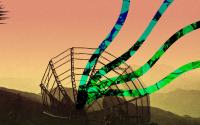24 October 2005
"I am 53 years old and I have never seen anything like this," said environmentalist Leoncio Menezes, describing the drought that has plagued the Jurúa River valley, in the extreme western part of Brazil near the Peruvian border, for several months. "Luckily it has rained in the past few days, and the rising water level has made transport possible again in the valley, where the small farmers living along the river had been unable to sell their corn, rice, beans and mandioca flour," he told IPS by telephone from Cruzeiro del Sur, the biggest town in the western portion of the state of Acre. Rivers are not only the main source of water for people in the Amazon jungle, but are also their primary means of transport. Hundreds of villages have been isolated by the drought, especially in the states of Acre and Amazonas, and are suffering shortages of clean water because their natural springs or other sources of water have dried up or suffered contamination. Earlier this month, the government of the state of Amazonas launched the SOS Interior emergency assistance plan, involving distribution by armed forces' helicopters of food and medicine to 914 isolated communities. The aid has now been extended to villages facing the threat of famine and epidemics in the state of Pará in Brazil's eastern Amazon jungle, where the Amazon River flows into the Atlantic Ocean. This year, much of the Amazonia region has registered the lowest rainfall in 40 years, similar to the levels seen in 1963 and 1964, reported the National Institute of Space Research (INPE) Centre for Weather Forecasting and Climate Studies. The water in the Negro River - along whose banks is located Manaus, a city of over 1.5 million that is the capital of the state of Amazonas - is at its lowest level since 1903, said Carlos Nobre, an INPE researcher. The Federation of Fisherfolk in the Amazon says the drought and subsequent dying off of fish have left 20 percent of the 120,000 fisherpeople in the state out of work. And there are fears that the situation will worsen over the next year, because the drastic reduction in the number of fish has limited their breeding capacity. The shortage of rainfall since June mainly affected the headwaters or middle stretches of the numerous rivers in the western and southern Amazon River basin, where the land is so flat that the rivers flow slowly, and any rise in water level takes weeks to reach the east. Even if the rainfall that began last week in Acre, Colombia and Peru intensifies, conditions in the major Amazon basin rivers in the area will not return to normal until the second half of November. In the town of Tefé, on the Solimoes River, a tributary that joins with the Negro River to form the Amazon River, the rains have been normal in the past few months, but the water level in the lake that links the town to the river has dropped off sharply, causing urban water supply problems, Fabio de Oliveira, the city government's communications secretary, told IPS. Oliveira expressed concern over the drop in the water level in the river's upper reaches The largest vessels are now forced to anchor, and transportation across the lake is taking place in small boats. In the town of Tabatinga, on the border with Colombia, the port had to be closed after it turned into a bog. In Acre, because of the low precipitations, fires have gotten out of control when farmers and ranchers use the slash and burn technique to clear land. The fires have spread to the surrounding forest, leaving much of the state under dense clouds of smoke for weeks. The worst situation was seen in the Acre River, which crosses the eastern part of the state of Acre. At one point, it was possible to walk across the river, which had slowed to a mere thread of water, said Paulo Moutinho, coordinator of the Amazon Institute of Environmental Research (IPAM). The current drought is a warning for the entire population on the need "to improve our relations with the environment," said Menezes, who criticised the image promoted by the press that the Acre state government is preserving the jungle. The state has become famous for innovative projects like a series of reserves where forest products are extracted in a sustainable manner. Some meteorologists say the current conditions are within the range of normal cyclical climate patterns seen in the Amazon jungle region. Similar conditions were seen in 1926, 1963, 1964 and, to a lesser extent, in other years. But "no one was expecting such low water levels," José Antonio Marengo, an INPE expert in climate variability, commented to IPS. Water levels drop seasonally in the Amazon jungle from June to September or October. This year's drought was worse than conditions seen in many years, but it remains within the limits of the variability that can be expected in the Amazon jungle, said Marengo, who does not think it can be taken as a reflection of global climate change. But if the rains do not begin in November or December, when the rainy season starts, that could be considered a real problem, he added. "The global climate is interconnected," but it cannot be stated that the same warming of the waters of the North Atlantic that has led to an intensification of hurricanes in the Gulf of Mexico has also caused the low water levels in the Amazon, he argued. Marengo and other researchers attribute this year's low precipitation levels to the fact that the "intertropical convergence" - low pressure that forms when the northeast trade winds meet the southeast trade winds - occurred slightly farther to the north, which meant the usual rains did not arrive in the western and southern part of the Amazon jungle region. (END/2005)






